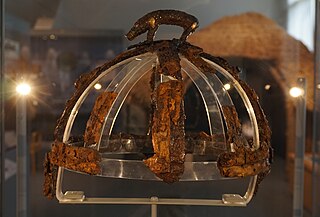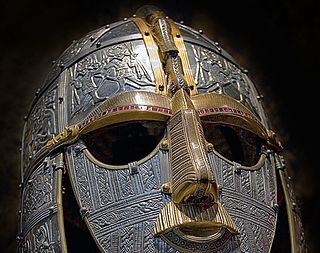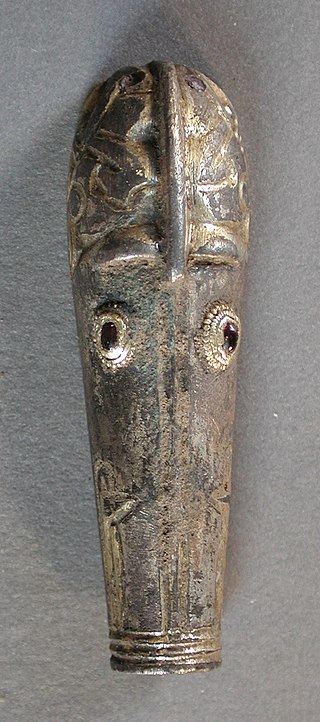
Sutton Hoo is the site of two Anglo-Saxon cemeteries dating from the 6th to 7th centuries near Woodbridge, Suffolk, England. Archaeologists have been excavating the area since 1938, when an undisturbed ship burial containing a wealth of Anglo-Saxon artifacts was discovered. The site is important in establishing the history of the Anglo-Saxon kingdom of East Anglia as well as illuminating the Anglo-Saxons during a period which lacks historical documentation.

The Benty Grange helmet is an Anglo-Saxon boar-crested helmet from the seventh century AD. It was excavated by Thomas Bateman in 1848 from a tumulus at the Benty Grange farm in Monyash in western Derbyshire. The grave had probably been looted by the time of Bateman's excavation, but still contained other high-status objects suggestive of a richly furnished burial, such as the fragmentary remains of a hanging bowl. The helmet is displayed at Sheffield's Weston Park Museum, which purchased it from Bateman's estate in 1893.

Rupert Leo Scott Bruce-Mitford was a British archaeologist and scholar. He spent the majority of his career at the British Museum, primarily as the Keeper of the Department of British and Medieval Antiquities, and was particularly known for his work on the Sutton Hoo ship-burial. Considered the "spiritus rector" of such research, he oversaw the production of the monumental three-volume work The Sutton Hoo Ship-Burial, termed by the president of the Society of Antiquaries as "one of the great books of the century".
Sir Herbert George Fordham, was a British writer on cartography whose Carto-Bibliography method of cataloging maps was widely adopted. He was the benefactor of the Fordham collection housed by the Royal Geographical Society - one of the most important map collections in the country.

The Sutton Hoo helmet is a decorated Anglo-Saxon helmet found during a 1939 excavation of the Sutton Hoo ship-burial. It was buried around the years c. 620–625 AD and is widely associated with an Anglo-Saxon leader, King Rædwald of East Anglia; its elaborate decoration may have given it a secondary function akin to a crown. The helmet was both a functional piece of armour and a decorative piece of metalwork. An iconic object from an archaeological find hailed as the "British Tutankhamen", it has become a symbol of the Early Middle Ages, "of Archaeology in general", and of England.

The Pioneer Helmet is an Anglo-Saxon boar-crested helmet from the late seventh century found in Wollaston, Northamptonshire, United Kingdom. It was discovered during a March 1997 excavation before the land was to be mined for gravel and was part of the grave of a young man. Other objects in the grave, such as a hanging bowl and a pattern welded sword, suggest that it was the burial mound of a high-status warrior.

The Shorwell helmet is an Anglo-Saxon helmet from the early to mid-sixth century AD found near Shorwell on the Isle of Wight in southern England. It was one of the grave goods of a high-status Anglo-Saxon warrior, and was found with other objects such as a pattern-welded sword and hanging bowl. One of only six known Anglo-Saxon helmets, alongside those found at Benty Grange (1848), Sutton Hoo (1939), Coppergate (1982), Wollaston (1997), and Staffordshire (2009), it is the sole example to derive from the continental Frankish style rather than the contemporaneous Northern "crested helmets" used in England and Scandinavia.

Many different weapons were created and used in Anglo-Saxon England between the fifth and eleventh centuries. Spears, used for piercing and throwing, were the most common weapon. Other commonplace weapons included the sword, axe, and knife—however, bows and arrows, as well as slings, were not frequently used by the Anglo-Saxons. For defensive purposes, the shield was the most common item used by warriors, although sometimes mail and helmets were used.

The Staffordshire helmet is an Anglo-Saxon helmet discovered in 2009 as part of the Staffordshire Hoard. It is part of the largest discovery of contemporary gold and silver metalwork in Britain, which contained more than 4,000 precious fragments, approximately a third of which came from a single high-status helmet. Following those found at Benty Grange (1848), Sutton Hoo (1939), Coppergate (1982), Wollaston (1997), and Shorwell (2004), it is only the sixth known Anglo-Saxon helmet.
Ian David Meadows is a British archaeologist. He has worked in archaeology for some 40 years, including as a Senior Project Officer at Northamptonshire Archaeology from 1992 to 2014. During that time he excavated a number of large quarries in England and Wales, and excavated the boar-crested Anglo-Saxon Pioneer Helmet in addition to discovering the first definitive evidence for viticulture in Roman Britain. He has also worked for the Museum of London Archaeology, and has taught archaeology and landscape history for Cambridge University, Anglia Ruskin University, the University of Bath, and the Workers' Educational Association.
Hans Klumbach was a German archaeologist and scholar of classical and provincial Roman studies. He served as a curator at, and later the director of, the Romano-Germanic Central Museum. His 1973 work Spätrömische Gardehelme laid bare the relationship between the late Roman ridge helmets and the later Scandinavian and Anglo-Saxon crested helmets.

The Gevninge helmet fragment is the dexter eyepiece of a helmet from the Viking Age or end of the Nordic Iron Age. It was found in 2000 during the excavation of a Viking farmstead in Gevninge, near Lejre, Denmark. The fragment is moulded from bronze and gilded, and consists of a stylised eyebrow with eyelashes above an oval opening. There are three holes at the top and bottom of the fragment to affix the eyepiece to a helmet. The fragment is significant as rare evidence of contemporaneous helmets, and also for its discovery in Gevninge, an outpost that is possibly connected to the Anglo-Saxon epic Beowulf. It has been in the collection of the Lejre Museum since its discovery, and has been exhibited internationally as part of a travelling exhibition on Vikings.

The Lokrume helmet fragment is a decorated eyebrow piece from a Viking Age helmet. It is made of iron, the surface of which is covered with silver and features an interlace pattern in niello or wire. Discovered in Lokrume, a small settlement on the Swedish island of Gotland, the fragment was first described in print in 1907 and is in the collection of the Gotland Museum.

Benty Grange is a Site of Special Scientific Interest in the parish of Monyash in Derbyshire, England. 21.1 ha in size and with at least four species of grass and ten others of plant, it is considered of national importance as one of the largest areas of unimproved species-rich neutral lowland grassland in the Peak District National Park. The area was confirmed as a Site of Special Scientific Interest on 8 March 2013, following notification of the designation on 19 June 2012.

The Horncastle boar's head is an early seventh-century Anglo-Saxon ornament depicting a boar that probably was once part of the crest of a helmet. It was discovered in 2002 by a metal detectorist searching in the town of Horncastle, Lincolnshire. It was reported as found treasure and acquired for £15,000 by the Lincoln City and County Museum—now Lincoln Museum—where it is on permanent display.
Leslie Elizabeth Webster, is an English retired museum curator and art historian of Anglo-Saxon and Viking art. She worked from 1964 until 2007 at the British Museum, rising to Keeper, where she curated several major exhibitions, and published many works, on the Anglo-Saxons and Early Middle Ages.

The Benty Grange hanging bowl is a fragmentary Anglo-Saxon artifact from the seventh century AD. All that remains are parts of two escutcheons: bronze frames that are usually circular and elaborately decorated, and that sit along the outside of the rim or at the interior base of a hanging bowl. A third one disintegrated soon after excavation, and it no longer survives. The escutcheons were found in 1848 by the antiquary Thomas Bateman, while excavating a tumulus at the Benty Grange farm in western Derbyshire. They were presumably buried as part of an entire hanging bowl. The grave had probably been looted by the time of Bateman's excavation, but still contained high-status objects suggestive of a richly furnished burial, including the hanging bowl and the boar-crested Benty Grange helmet.
Jennifer Foster is an English scholar of prehistoric and medieval archaeology, who specializes in the study of artifacts, particularly metalwork.

The Hellvi helmet eyebrow is a decorative eyebrow from a Vendel Period helmet. It comprises two fragments; the arch is made of iron decorated with strips of silver, and terminates in a bronze animal head that was cast on. The eyebrow was donated to the Statens historiska museum in November 1880 along with several other objects, all said to be from a grave find in Gotland, Sweden.

Germanic boar helmets or boar crested helmets are attested in archaeological finds from England, Denmark and Sweden, dating to Vendel and Anglo-Saxon periods, and Old English and Old Norse written sources. They consist of helmets decorated with either a boar crest or other boar imagery that was believed to offer protection in battle to the wearer. They have also been proposed to be a costume for the ritual transformation into a boar, similar to berserkers, and to be associated with Freyr.




















